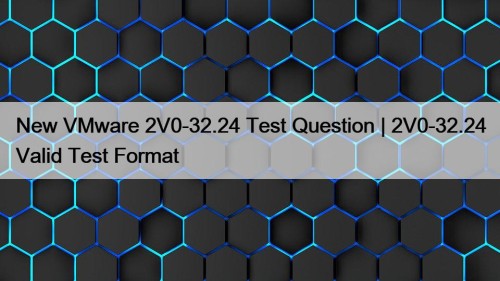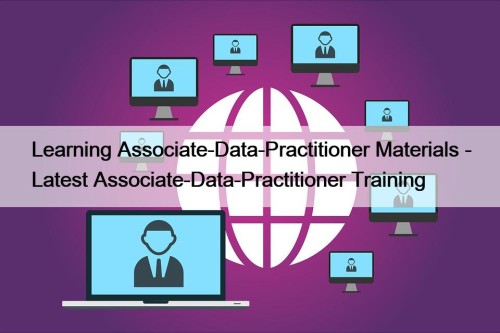Most Popular
 Advanced-Cross-Channel Test Study Guide - Advanced-Cross-Channel Test Simulator
Advanced-Cross-Channel Test Study Guide - Advanced-Cross-Channel Test Simulator
P.S. Free & New Advanced-Cross-Channel dumps are available on Google ...
 New VMware 2V0-32.24 Test Question | 2V0-32.24 Valid Test Format
New VMware 2V0-32.24 Test Question | 2V0-32.24 Valid Test Format
Would you like to register VMware 2V0-32.24 certification test? Would ...
 Learning Associate-Data-Practitioner Materials - Latest Associate-Data-Practitioner Training
Learning Associate-Data-Practitioner Materials - Latest Associate-Data-Practitioner Training
To stay updated and competitive in the market you have ...



Learning Associate-Data-Practitioner Materials - Latest Associate-Data-Practitioner Training

To stay updated and competitive in the market you have to upgrade your skills and knowledge level. Fortunately, with the Google Cloud Associate Data Practitioner (Associate-Data-Practitioner) certification exam you can do this job easily and quickly. To do this you just need to pass the Associate-Data-Practitioner certification exam. The Google Cloud Associate Data Practitioner (Associate-Data-Practitioner) certification exam is the top-rated and career advancement Google Associate-Data-Practitioner Certification in the market. This Google certification is a valuable credential that is designed to validate your expertise all over the world. After successfully competition of Associate-Data-Practitioner exam you can gain several personal and professional benefits.
The Google Cloud Associate Data Practitioner (Associate-Data-Practitioner) certification exam is one of the top-rated career advancement certification exams. The Google Cloud Associate Data Practitioner (Associate-Data-Practitioner) certification exam can play a significant role in career success. With the Google Cloud Associate Data Practitioner (Associate-Data-Practitioner) certification you can gain several benefits such as validation of skills, career advancement, competitive advantage, continuing education, and global recognition of your skills and knowledge. The Google Cloud Associate Data Practitioner (Associate-Data-Practitioner) certification is a valuable credential that assists you to enhance your existing skills and experience.
>> Learning Associate-Data-Practitioner Materials <<
Learning Associate-Data-Practitioner Materials | Google Latest Associate-Data-Practitioner Training: Google Cloud Associate Data Practitioner Pass for Sure
Our customer service is available 24 hours a day. You can contact us by email or online at any time. In addition, all customer information for purchasing Google Cloud Associate Data Practitioner test torrent will be kept strictly confidential. We will not disclose your privacy to any third party, nor will it be used for profit. Then, we will introduce our products in detail. On the one hand, Google Cloud Associate Data Practitioner test torrent is revised and updated according to the changes in the syllabus and the latest developments in theory and practice. On the other hand, a simple, easy-to-understand language of Associate-Data-Practitioner Test Answers frees any learner from any learning difficulties - whether you are a student or a staff member. These two characteristics determine that almost all of the candidates who use Associate-Data-Practitioner guide torrent can pass the test at one time. This is not self-determination.
Google Associate-Data-Practitioner Exam Syllabus Topics:
| Topic | Details |
|---|---|
| Topic 1 |
|
| Topic 2 |
|
| Topic 3 |
|
Google Cloud Associate Data Practitioner Sample Questions (Q80-Q85):
NEW QUESTION # 80
You have millions of customer feedback records stored in BigQuery. You want to summarize the data by using the large language model (LLM) Gemini. You need to plan and execute this analysis using the most efficient approach. What should you do?
- A. Export the raw BigQuery data to a CSV file, upload it to Cloud Storage, and use the Gemini API to summarize the data.
- B. Create a BigQuery Cloud resource connection to a remote model in Vertex Al, and use Gemini to summarize the data.
- C. Query the BigQuery table from within a Python notebook, use the Gemini API to summarize the data within the notebook, and store the summaries in BigQuery.
- D. Use a BigQuery ML model to pre-process the text data, export the results to Cloud Storage, and use the Gemini API to summarize the pre- processed data.
Answer: B
Explanation:
Creating a BigQuery Cloud resource connection to a remote model in Vertex AI and using Gemini to summarize the data is the most efficient approach. This method allows you to seamlessly integrate BigQuery with the Gemini model via Vertex AI, avoiding the need to export data or perform manual steps. It ensures scalability for large datasets and minimizes data movement, leveraging Google Cloud's ecosystem for efficient data summarization and storage.
NEW QUESTION # 81
Your organization's business analysts require near real-time access to streaming dat a. However, they are reporting that their dashboard queries are loading slowly. After investigating BigQuery query performance, you discover the slow dashboard queries perform several joins and aggregations.
You need to improve the dashboard loading time and ensure that the dashboard data is as up-to-date as possible. What should you do?
- A. Create a scheduled query to calculate and store intermediate results.
- B. Create materialized views.
- C. Modify the schema to use parameterized data types.
- D. Disable BiqQuery query result caching.
Answer: B
Explanation:
Creating materialized views is the best solution to improve dashboard loading time while ensuring that the data is as up-to-date as possible. Materialized views precompute and cache the results of complex joins and aggregations, significantly reducing query execution time for dashboards. They also automatically update as the underlying data changes, ensuring near real-time access to fresh data. This approach optimizes query performance and provides an efficient and scalable solution for streaming data dashboards.
NEW QUESTION # 82
You manage a BigQuery table that is used for critical end-of-month reports. The table is updated weekly with new sales dat a. You want to prevent data loss and reporting issues if the table is accidentally deleted. What should you do?
- A. Schedule the creation of a new snapshot of the table once a week. On deletion, re-create the deleted table using the snapshot and time travel data.
- B. Configure the time travel duration on the table to be exactly seven days. On deletion, re-create the deleted table solely from the time travel data.
- C. Create a view of the table. On deletion, re-create the deleted table from the view and time travel data.
- D. Create a clone of the table. On deletion, re-create the deleted table by copying the content of the clone.
Answer: A
Explanation:
Scheduling the creation of a snapshot of the table weekly ensures that you have a point-in-time backup of the table. In case of accidental deletion, you can re-create the table from the snapshot. Additionally, BigQuery's time travel feature allows you to recover data from up to seven days prior to deletion. Combining snapshots with time travel provides a robust solution for preventing data loss and ensuring reporting continuity for critical tables. This approach minimizes risks while offering flexibility for recovery.
NEW QUESTION # 83
You work for an online retail company. Your company collects customer purchase data in CSV files and pushes them to Cloud Storage every 10 minutes. The data needs to be transformed and loaded into BigQuery for analysis. The transformation involves cleaning the data, removing duplicates, and enriching it with product information from a separate table in BigQuery. You need to implement a low-overhead solution that initiates data processing as soon as the files are loaded into Cloud Storage. What should you do?
- A. Create a Cloud Data Fusion job to process and load the data from Cloud Storage into BigQuery. Create an OBJECT_FINALI ZE notification in Pub/Sub, and trigger a Cloud Run function to start the Cloud Data Fusion job as soon as new files are loaded.
- B. Use Dataflow to implement a streaming pipeline using an OBJECT_FINALIZE notification from Pub/Sub to read the data from Cloud Storage, perform the transformations, and write the data to BigQuery.
- C. Schedule a direct acyclic graph (DAG) in Cloud Composer to run hourly to batch load the data from Cloud Storage to BigQuery, and process the data in BigQuery using SQL.
- D. Use Cloud Composer sensors to detect files loading in Cloud Storage. Create a Dataproc cluster, and use a Composer task to execute a job on the cluster to process and load the data into BigQuery.
Answer: B
Explanation:
Using Dataflow to implement a streaming pipeline triggered by an OBJECT_FINALIZE notification from Pub/Sub is the best solution. This approach automatically starts the data processing as soon as new files are uploaded to Cloud Storage, ensuring low latency. Dataflow can handle the data cleaning, deduplication, and enrichment with product information from the BigQuery table in a scalable and efficient manner. This solution minimizes overhead, as Dataflow is a fully managed service, and it is well-suited for real-time or near-real-time data pipelines.
NEW QUESTION # 84
Another team in your organization is requesting access to a BigQuery dataset. You need to share the dataset with the team while minimizing the risk of unauthorized copying of dat a. You also want to create a reusable framework in case you need to share this data with other teams in the future. What should you do?
- A. Export the dataset to a Cloud Storage bucket in the team's Google Cloud project that is only accessible by the team.
- B. Create authorized views in the team's Google Cloud project that is only accessible by the team.
- C. Enable domain restricted sharing on the project. Grant the team members the BigQuery Data Viewer IAM role on the dataset.
- D. Create a private exchange using Analytics Hub with data egress restriction, and grant access to the team members.
Answer: D
Explanation:
Using Analytics Hub to create a private exchange with data egress restrictions ensures controlled sharing of the dataset while minimizing the risk of unauthorized copying. This approach allows you to provide secure, managed access to the dataset without giving direct access to the raw data. The egress restriction ensures that data cannot be exported or copied outside the designated boundaries. Additionally, this solution provides a reusable framework that simplifies future data sharing with other teams or projects while maintaining strict data governance.
NEW QUESTION # 85
......
PracticeTorrent provides the most up-to-date Google Cloud Associate Data Practitioner Associate-Data-Practitioner exam questions and practice material to assist you in preparing for the Google Associate-Data-Practitioner exam. Our Google Cloud Associate Data Practitioner Associate-Data-Practitioner exam questions preparation material helps countless people worldwide in becoming certified professionals. Our Google Cloud Associate Data Practitioner Associate-Data-Practitioner Exam Questions are available in three simple formats, allowing customers to select the most appropriate option according to their needs.
Latest Associate-Data-Practitioner Training: https://www.practicetorrent.com/Associate-Data-Practitioner-practice-exam-torrent.html
- Associate-Data-Practitioner Reliable Dump ☯ Pass4sure Associate-Data-Practitioner Dumps Pdf 📮 Latest Associate-Data-Practitioner Dumps Free ⬇ ( www.getvalidtest.com ) is best website to obtain ▷ Associate-Data-Practitioner ◁ for free download ⛲Associate-Data-Practitioner Reliable Test Objectives
- Latest Associate-Data-Practitioner Dumps Free 🦎 Associate-Data-Practitioner Valid Test Vce 🤹 Pass4sure Associate-Data-Practitioner Dumps Pdf 😸 Search on ▛ www.pdfvce.com ▟ for [ Associate-Data-Practitioner ] to obtain exam materials for free download 🙊Exam Associate-Data-Practitioner Demo
- Associate-Data-Practitioner Valid Test Vce ⬅ Latest Associate-Data-Practitioner Exam Papers 🤢 Latest Associate-Data-Practitioner Braindumps Free ⬆ Go to website 「 www.exams4collection.com 」 open and search for “ Associate-Data-Practitioner ” to download for free 😒Associate-Data-Practitioner Valid Test Vce
- Latest Associate-Data-Practitioner Exam Papers 🐅 Exam Discount Associate-Data-Practitioner Voucher 🎷 Associate-Data-Practitioner Exam Cram Questions 🧸 Search for ➡ Associate-Data-Practitioner ️⬅️ and obtain a free download on ▛ www.pdfvce.com ▟ 💏Latest Associate-Data-Practitioner Dumps Free
- 100% Pass Associate-Data-Practitioner - Google Cloud Associate Data Practitioner –Valid Learning Materials 👕 ⮆ www.dumps4pdf.com ⮄ is best website to obtain 【 Associate-Data-Practitioner 】 for free download 🈵Associate-Data-Practitioner Reliable Test Objectives
- Associate-Data-Practitioner Most Reliable Questions 🪓 Pass4sure Associate-Data-Practitioner Dumps Pdf 🗼 Latest Associate-Data-Practitioner Dumps Free 🤯 Search for ▷ Associate-Data-Practitioner ◁ and obtain a free download on ➽ www.pdfvce.com 🢪 🥝Associate-Data-Practitioner Reliable Dump
- Associate-Data-Practitioner Reliable Braindumps Ppt 👹 Exam Associate-Data-Practitioner Cram Questions 🏕 Latest Associate-Data-Practitioner Exam Papers 🥱 Enter ➡ www.vceengine.com ️⬅️ and search for ➡ Associate-Data-Practitioner ️⬅️ to download for free 🥨Reliable Associate-Data-Practitioner Exam Guide
- Reliable Associate-Data-Practitioner Exam Guide ⚖ Exam Associate-Data-Practitioner Cram Questions 🔤 Associate-Data-Practitioner Valid Test Vce 🌙 Easily obtain free download of ➤ Associate-Data-Practitioner ⮘ by searching on ⇛ www.pdfvce.com ⇚ 😜Associate-Data-Practitioner Valid Test Vce
- 100% Pass Associate-Data-Practitioner - Google Cloud Associate Data Practitioner –Valid Learning Materials 😊 Go to website ➡ www.real4dumps.com ️⬅️ open and search for ▶ Associate-Data-Practitioner ◀ to download for free 🔺Accurate Associate-Data-Practitioner Prep Material
- 100% Pass Associate-Data-Practitioner - Google Cloud Associate Data Practitioner –Valid Learning Materials ➡️ ( www.pdfvce.com ) is best website to obtain 「 Associate-Data-Practitioner 」 for free download 🤿Associate-Data-Practitioner Reliable Dump
- 100% Pass Google - Associate-Data-Practitioner - The Best Learning Google Cloud Associate Data Practitioner Materials 〰 Search on ▷ www.torrentvalid.com ◁ for ⇛ Associate-Data-Practitioner ⇚ to obtain exam materials for free download 🖌Associate-Data-Practitioner Reliable Dump
- Associate-Data-Practitioner Exam Questions
- zimeng.zfk123.xyz www.skillstopaythebills.co.uk careerxpand.com unikaushal.futurefacetech.in www.qlmlearn.com learning-camp.com learn.educatingeverywhere.com smartskillup.com cyberneticsstemacademy.com elearning.eauqardho.edu.so
Tags: Learning Associate-Data-Practitioner Materials, Latest Associate-Data-Practitioner Training, Associate-Data-Practitioner Frequent Updates, Associate-Data-Practitioner Valid Exam Papers, Associate-Data-Practitioner Latest Exam Dumps